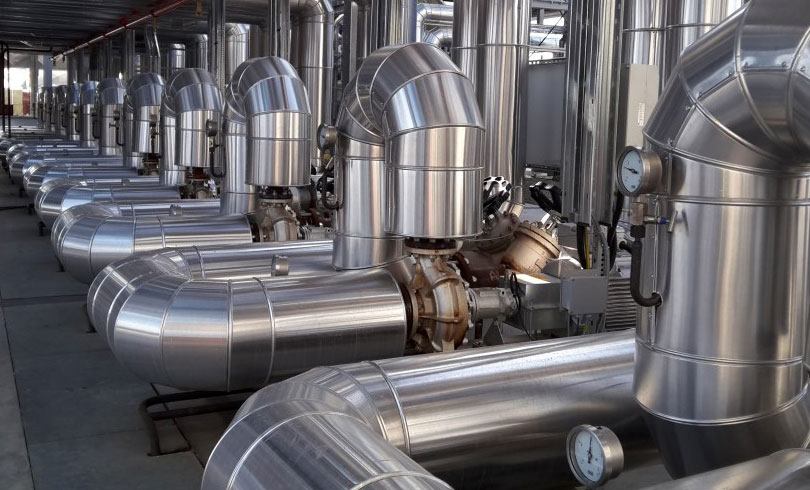
1. Introduction
Syltherm 800 stabilized Heat Transfer Fluid (HTF) is a product, trademark by Dow Chemicals Co.
Syltherm 800 is a highly stable silicone fluid designed for high temperature operation. The mentioned heat transfer fluid ( HTF ) has a recommended operating range from – 40°C to 400°C. Syltherm 800 fluid shows a low potential for fouling and can remain in service for 10 years or even more.
The main characteristics of Syltherm 800 are the followings :
• Low freeze point
• Low fouling potential
• High-temperature stability
• Non-corrosive
• Long shelf-life
• Low acute oral toxicity
• Low odor
The chemical composition of Syltherm 800 is a mixture consisting of stabilized Polydimethylsiloxane: 98.0 – 100.0% with Zirconium octanoate: 0.5 – 1.5 %.
Under operational thermal stress, the Syltherm 800 fluid undergoes a very slow rearrangement of the silicone-oxygen bonds in order to assume a structure that remains stable at the high required temperatures and pressure. The molecular rearrangement rate is directly related to the temperature. The low-molecular weight linear and cyclic siloxanes that result from this rearrangement remain as part of the heat transfer media and do not cause system fouling. Therefore, the molecular rearrangement that occurs is not a degradation reaction and consequently does not affect the heat transfer fluid shelf-life [1].
2. Physical and chemical properties
• Physical state : Liquid.
• Color : Colorless to yellow
• Odor : Odorless to mild odor
• Freezing point : -60 °C ( -76 °F)
• Flash point, closed cup : > 160 °C ( > 320 °F)
• Fire point : 193°C ( 380°F)
• Evaporation rate (Butyl Acetate = 1) : < 5 mmHg at 25 °C (77 °F)
• Acid number, typical : 0,03
• Relative Density (water = 1) : 0.935 at 25 °C (77 °F)
• Water solubility : < 100 ppb
• Auto ignition temperature : 385 °C (725 °F)
• Kinematic Viscosity : 9.8 cSt at 25 °C (77 °F)
The exceptional thermal stability of Syltherm 800 HTF results in unique stable heat transfer properties. Additionally, the rearrangement chemistry of Syltherm 800 structure can offset the viscosity increase, characteristic of HTF fluids as they are aging. As consequence, the film heat transfer fluid can remain as good as or even improve the original fluid values. Syltherm 800 is sensitive to contamination at elevated temperatures. The contamination by bases or acids can result in accelerated rates of volatile by-products. On the other hand, contamination by oxygen, water or other oxidants can provoke the cross-linking of polymer macromolecules and cause a gradual viscosity increase. Consequently, it is important to minimize the contamination by appraising the potential sources of contamination such as water, steam, atmospheric air and process materials.
3. Toxicological and safety considerations
Syltherm 800 heat transfer fluid has been studied for toxicological properties under the Federal Hazardous Substance Act ( FHSA ) guidelines. The FSHA study concluded that:
• Syltherm 800 is nontoxic in regard to dermal absorption or acute oral ingestion
• Syltherm 800 is not irritant to eyes and skin
Additional studies indicate also that repeated, prolonged skin contact should not result in irritation. Normal routine industrial handling procedures are adequate to handle the mentioned product.
The predominant vented by-products of Syltherm 800 due to thermal decomposition are low-molecular weight dimethylsiloxanes. The low toxicity of those linear and cyclic siloxanes is certified by their common use in such personal care products as cosmetics and deodorants.
4. Recycling considerations and disposal methods:
It is recommended not to dump the product into any sewers, on the ground or into any body of water. All disposal practices must be in compliance with all Federal, State/Provincial and local laws and regulations. Regulations may vary in different locations. Recycle material characterizations and compliance with applicable laws are the responsibility solely of the recycle material generator: Used heat transfer fluid which has been stored in drums or tanks should be sampled before recycling in such a manner as to ensure a representative sample.
The regeneration recycling feasibility of the wide-spec heat transfer fluids (HTF) was also researched using the rotary steam-filtration-adsorption method and the indicators of reclaimed oil were tested according to the current standards [2].
The good oil in wide-spec heat transfer fluids was about 50% through the regeneration recycle.
Though the recycling of HTF oil would be used as a fuel oil supply for the refinery, it is a serious waste of resources, moreover, it will lead to an environmental pollution for which now there are regulations and management system standards. Therefore, to regenerate and recycle the HTF has very important practical significance for the enterprises to reduce the production cost, to save energy and protect the environment. In the regeneration process, procedures as reduced pressure rotary steaming, adsorption and filtration were adopted for different types of silicone oil. Then every index of the oil was analyzed according to current standards to determine the feasibility of the renewable technology based on the experimental results.
For unused and uncontaminated product, the preferred options include sending to a licensed Recycler as for instance ECO USA, incinerator or other thermal destruction device.
References:[ 1 ] www.dow.com[ 2 ] 2016 2nd International Conference on Sustainable Energy and Environmental Engineering (SEEE 2016) –“ The Experimental Research on the Regeneration and Recycling Feasibility of the Waste Heat Transfer Fluids” Yu-hui DU1 , Bin YUAN2,*, Lin YANG1 and Wei-Guang, Guangzhou, 510006, China



